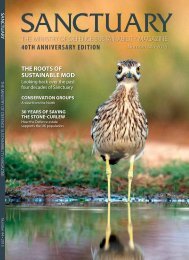SUSTAINABILITY
UC30G
UC30G
You also want an ePaper? Increase the reach of your titles
YUMPU automatically turns print PDFs into web optimized ePapers that Google loves.
FEATURES<br />
award for carrying out an important<br />
environmental project on the MOD<br />
estate. In the eight years or so since the<br />
award, the group has not rested on its<br />
laurels. In fact it is going from strength<br />
to strength; its members are<br />
represented on the Holcombe Moor<br />
conservation group and their work is<br />
helping to cement relations between<br />
the MOD and the local community.<br />
Alongside the work that many<br />
conservation groups do to document<br />
the historic value of MOD land, a key<br />
focus of any meeting will usually<br />
involve activities to monitor and<br />
protect the wealth of biodiversity and<br />
environmental features within the<br />
militar y estate. With around 227,000ha<br />
of land owned directly plus a similar<br />
area used under various rights and<br />
agreements, the responsibilities and<br />
opportunities are considerable and the<br />
contributions of local volunteers and<br />
other stakeholders are an important<br />
component of how MOD manages<br />
some of the highest value wildlife<br />
habitats in the UK.<br />
Barry Buddon, near Dundee, is a busy<br />
training area which gained national<br />
publicity when it hosted the target<br />
shooting elements of the recent<br />
Commonwealth Games. The<br />
conservation group led by Capt Harry<br />
Roy are an enthusiastic bunch with<br />
decades of combined experience of the<br />
extensive dunes that surround the<br />
ranges, and each year the group focus<br />
on two major community involvement<br />
events in addition to their own interests<br />
on site. In April Barry Buddon hosted its<br />
big beach clean up in conjunction with<br />
Angus Council, bringing together local<br />
groups such as the Rotary Club to help<br />
clear tonnes of rubbish that gets<br />
washed up every year, and in August<br />
the annual nature day gave a range of<br />
local naturalist groups the chance to<br />
have extensive access to the site to<br />
record everything from birds to botany<br />
and moths to mammals in a mini<br />
bio-blitz that has been known to turn<br />
up a few surprises as well.<br />
Conservation group members also<br />
contribute to some of the work that<br />
Defence Infrastructure Organisation<br />
(DIO) does to support military training,<br />
for example one upland site in Scotland<br />
where parachute drops are carried out<br />
as part of annual training exercises on an<br />
area that also happens to be designated<br />
a Special Protection Area due to the<br />
presence of breeding hen harriers. While<br />
the DIO Ecology Team deal with<br />
statutory assessments and consents and<br />
the military staff plan the exercise,<br />
ornithologist Geoff Sheppard from the<br />
West Freugh conservation group<br />
identifies the locations of harrier<br />
territories when they return from their<br />
winter migration, liaises with the<br />
Exercise Planner to mark these areas<br />
with a 500m buffer zone as out of<br />
bounds, and continues to monitor the<br />
nests under licence until the end of the<br />
breeding season. This arrangement has<br />
worked well for a number of years now,<br />
and although monitoring shows the<br />
hen harrier numbers are declining in line<br />
with national trends, we are confident as<br />
a result of Geoff’s consistent monitoring<br />
that any nest failures are not the result of<br />
military activity.<br />
These are just a few examples from<br />
MOD conservation groups across the<br />
UK whose members can be as diverse<br />
as the sites they are involved with. Like<br />
any relationship a degree of give and<br />
take is involved, group members enjoy<br />
privileged levels of access to sites and<br />
the opportunity to be involved with<br />
unique conservation projects, and in<br />
return the MOD has continuity of local<br />
knowledge and involvement that<br />
helps support its activities and<br />
responsibilities for management. The<br />
system works well on the whole, and<br />
the input of our volunteers and other<br />
stakeholders is very much appreciated.<br />
Phil Abramson<br />
Archaeology Advisor<br />
John Black<br />
Ecologist North<br />
Defence Infrastructure Organisation<br />
Members of the HMHG excavating 18th/19th century cottages at Bottoms on the Holcombe Moor Training Area, near Bury, Lancashire © HMHG<br />
Sanctuary 44 • 2015<br />
19



